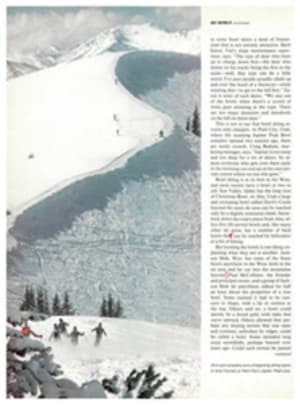
THE MONDAY NIGHT ALTERNATIVE
At the start of Monday football evenings, radio and television represent the difference between lively conversation after a good dinner and the sounds of carnival barkers. On the CBS Radio Network, Jack Buck and Hank Stram chat easily on such subjects as the problems of sacked quarterbacks and defenses, and then move smartly into the starting lineups for the forthcoming game. At the same time, television screens are flooded with commercials and rapid-fire plugs for ABC-TV network shows. On radio, Buck and Stram reflect upon the strategies of the teams about to play; on television, the images of Howard Cosell, Frank Gifford and Don Meredith appear, with music, fanfare and more salesmanship, and then the game begins. And what follows is a growing nationwide exercise in split-mind thinking.
To the 45 million or so folks who watch Monday Night Football, Gifford and Cosell talk the way they always do—the one delivering play-by-play with reasoned accuracy, the other riding horseback up and down the mountainous terrain of his own vocabulary. Meredith provides his unique kind of cornpone-quarterback relief. The format is familiar.
Meanwhile, a far smaller group of fans is immersed in the relatively new and stimulating experience of listening to the Buck and Stram Show, which began broadcasts of NFL Monday night games in September. The radio program pulls in about 10 million listeners, depending on the number of CBS stations—from 260 to 300 a week—that pick up the game. And there is little doubt that its popularity will continue to grow. Of course, quite a few of these listeners couldn't watch TV even if they wanted to, since they are riding in automobiles, but those at home have found that easy radio listening is an antidote to TV hype and hard sell.
At 54, Jack Buck is strictly a low-key old hand who has broadcast everything from bowling to hometown wrestling. His is a familiar bass voice. He is a non-hysterical, just-call-the-play announcer. He is also entirely human; during a two-year stint covering the Dallas Cowboys, Buck constantly referred to Pettis Norman as Norman Pettis. "In Dallas," he says, "I'm known as Buck Jack." Either way, Buck is backed nicely by Stram. The former coach of the Kansas City Chiefs (15 years) and New Orleans Saints (28 games) tells everybody that he would be delighted to get out of broadcasting if he could get back into coaching. But it would be a loss to radio if he did. Stram, 55, brings a fresh and incisive approach to the so-called analyst's spot. He manages to avoid the roles of unemployed messiah and jargon-strangled technician so often foisted upon helpless football fans.
Stram is both gutsy and casual about laying his knowledge on the line in terms of predicting the plays to be called, and he tells listeners why it figures that the quarterback or the defense will make certain moves. Sometimes he spots something in the formation—a slight deviation in the posture of a tight end—or he notices the repositioning of a linebacker. "I see things with a coach's eye, not as a former player who knows only one position," he says. "I try to call the games with my own insights. Anybody can give statistics and tell what hometowns the players are from. I talk about what I know—as a coach."
The delivery of this expertise is smooth and relaxed. "Jack Buck is the perfect play-by-play guy for me," Stram says. "He is economical and vivid in his descriptions and he gives me plenty of time to say what I think. Sometimes it can be terribly frustrating if I've got something to say and I can't get it in because the other guy won't stop talking. This doesn't happen with Jack; we've got a fine chemistry."
The chemistry also includes a television monitor in their broadcast booth, tuned to the ABC telecast. But Stram says he rarely looks at it. "We don't consider the TV guys as competition," he says. "They have their philosophy on presenting a game and we have ours. If I watched the monitor all the time, I'd tend to shortchange the listeners who only have a radio."
The television network also has a far different pricing philosophy: Monday night commercials cost some $170,000 per minute. The cost for radio varies considerably, but as one CBS spokesman put it, "If you took the price of a 30-second Super Bowl TV commercial, about $185,000, you could buy time on every one of our 36 NFL broadcasts."
Still, the idea of making CBS radio a sort of counter-TV attraction is spreading. Station WGST, the CBS affiliate in Atlanta, promotes its Buck-Stram broadcasts with the slogan TELEVISION SHOULD BE SEEN AND NOT HEARD. Advertising Age, commenting on Budweiser becoming a major sponsor of the radio show, reported, "Anheuser-Busch is banking on sports fans watching ABC's video, but tuning out Howard Cosell's audio and turning on CBS' radio coverage."
And that is indeed happening. The marriage of ABC video and CBS radio makes a nice electronic meld. The lively and informative words of Buck and Stram fit almost perfectly with the pictures appearing on the screen. The radio commercials are unobtrusive, and whatever they are ranting at you to buy on TV doesn't matter as long as the sound is off anyway. The TV silence is filled by Stram's explaining in lucid terms such things as why a linebacker winds up all alone covering the tight end who has just caught a 20-yard pass. Obviously, this is a most civilized use of mass communications.
PHOTO
STRAM CALLS THE SHOTS, BUCK CALLS THE PLAYS

